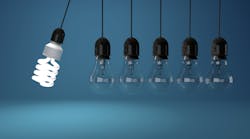When we open our favorite power business-related magazine or website, chances are we are greeted with news about the latest battery storage technology, inroads achieved with the newest renewable energy technologies or the latest advancements in smart grid technology. It is pretty rare these days to see breaking news on the subject of energy efficiency, unless, of course, one works in that niche of the business. So for some of us, at least, it was somewhat of a surprise when the EIA recently pointed to energy efficiency as a significant reason for the eye-popping 9 percent decline in residential electric sales per household since 2010.
EIA reported that weather is a significant driver of variation in residential electricity sales in many states, particularly over the short term. However, the agency believes the long term trends are due to increased investment in energy efficiency. We don’t hear a lot about those investments. They don’t make the front-page industry news like a new energy storage gizmo. Nonetheless, EIA reports that on average, from 2013 through 2015, electric utilities, energy efficiency program managers and other organizations provided an annual average of $3.92 in energy efficiency incentives per person. Direct energy efficiency investments varied by state with a range of $18 to $0.04 per person. In keeping with our stealth theme, those figures don’t knock one over unless we work through the math. The American Council for an Energy-Efficient Economy reported in its annual study that customer focused utility programs and efficiency improvements they made on their systems to reduce system energy losses amounted to an investment of about $7.7 billion in energy efficiency last year.
Now that reduction in residential energy use since 2010 starts to make sense if this level of investment has been going on behind the scene. Moreover, we can see that as quiet as this trend has been of late, the cumulative results are dramatic. Historically, the largest residential energy use was for space conditioning (heating and cooling). As a result of better insulated homes and higher efficiency standards on heating and cooling systems, this is no longer the case. Plus, the areas where consumption is now greatest (lighting, appliances and water heating) show significant promise for additional efficiency savings. For example, residential lighting is beginning to shift more rapidly from less efficient incandescent bulbs to more energy-efficient lighting, including compact fluorescent lamps (CFLs) and light-emitting diodes (LEDs).
The conversion to more efficient lighting was helped along by efforts since 2005 around the world to “ban” the manufacture and use of lower efficiency incandescent bulbs. The so-called “bulb ban” was really a case of over dramatization by the media because incandescents were not banned here in the U.S. as long as they could meet higher efficiency standards. The net result was roughly 30% on average more energy efficient lighting and with CFLs and LEDs becoming more cost effective all the time, lighting has the potential to become 80-90% more efficient than it was historically.
More generally, according to the EIA 30 states and the District of Columbia have adopted energy efficiency policies in the form of mandated requirements, voluntary goals, or pilot programs, all designed to lower the growth of electricity consumption. Quietly, or at least without the fanfare we see elsewhere, these policies which are often in the form of energy efficiency resource standards (EERS), use either financial incentives or non-performance penalties to encourage energy efficiency and reduce electricity sales. EERS may require reductions in energy use, peak electricity demand, or both and utilities as well as government organizations and businesses are impacted. Approaches to compliance may include updating building codes, transportation planning and even dusting off or ramping up traditional customer-incentive programs for heating, cooling and lighting improvement rebates.
Whether are not we agree that energy efficiency has been a stealth competitor in terms of investment or opportunities foregone for other technologies and sources of energy production, the customer is the obvious winner. It would be a fool’s errand these days to build a business strategy solely on the premise of increased electric/energy sales per capita. It may have been intuition or just a coincidence when many utilities dropped the phrase “and Light” from their names. And while we see “power” in utility names less and less these days, it’s a pretty good bet that part of the business will continue even if it is not growing as it once did. In the end, we all know the real focus of the utility business needs to be customer fulfillment.


